

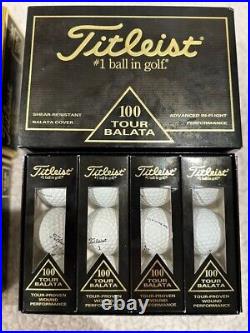
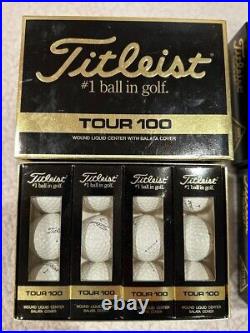

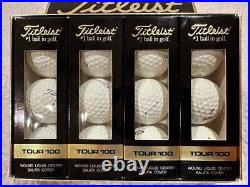

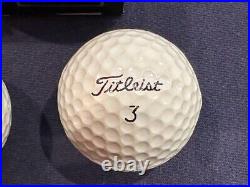

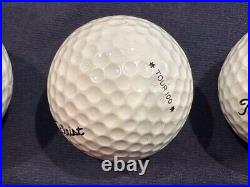

Vintage – New in Box- Titliest Tour Balata 100 golf balls. 2 dozen- 24 total. Some in one of the boxes are a bit bumpy. Looking Back at Balata Golf Balls (And Explaining What’Balata’ Is). Does anyone make or sell balata balls today? Not so long ago in golf history. Balata golf balls were the ball of choice for low-handicap golfers, and something the rest of us aspired to play. But what is balata? Why did balata balls disappear from golf? Balata Starts as a Tree Sap. “Balata” refers to a naturally occurring, rubber-like material that was once used for the cover on golf balls. “Balata balls” were used by professional golfers. And low-handicappers because the soft, balata cover allowed for much higher spin rates on iron and wedge shots, and greater control over ball flight by those highly skilled golfers. Balata is one of the names of a tree that grows in Central and South America and the Caribbean. The tree is tapped and the soft, viscous fluid that later hardens into the rubber-like material of golf ball fame is harvested just as one would harvest sap from a rubber tree or maple tree. First Use of Balata for Golf Balls. In the timeline of golf balls, balata balls arrived on the scene in the early 1900s. Spalding began producing golf balls with balata covers in 1903. What Made Balata Balls the’Pro’s Ball’? One of the main reasons balata was thought of as a “pro’s ball” or “low handicapper’s ball” was because that soft, balata cover cut so easily on mishits. Mid- and high-handicap golfers don’t make good, proper contact on a regular basis. If you bladed a balata ball, that cover was sure to cut, rendering the ball unplayable. Nicks, dents and scratches were common, as well, on mishits, or, for example, as the result of a balata ball bouncing off a paved cart path. Or into rocks or smashing into trees. In my earliest days as a golfer, a relative bought me a dozen personalized golf balls with my name emblazoned on them. But, not a golfer, he bought balata balls – thinking the pricier balls were naturally the best balls. But they definitely weren’t for a beginning golfer like me. That dozen balls was cut up in no time. I probably scuffed, dented and cut a ball per hole until the balls ran out. So balata balls were used by better golfers, while recreational golfers used golf balls made with harder, cut-resistant cover materials (Surlyn, a trademarked name and material developed by DuPont, is often remembered as the alternative to balata). Balata balls eventually disappeared when golf manufacturers. Began developing alternative cover materials (such as urethane) in the 1990s, materials that offered the soft feel of balata but were far more durable. Do Any Companies Make Balata Balls Today? No, as far as we know there are no golf ball manufacturers, large, small or specialty, that make new golf balls today using balata covers. Current golf balls are several orders more advanced technologically than the last generation of balata balls. But maybe you’re just curious and want to know what a balata ball felt like. Or maybe you have some vintage golf clubs and want to go all the way with some vintage balls, too. Unused, still-in-package balata balls are difficult to find, but not (for now) impossible. From a Golf Magazine article. We robot-tested modern equipment with a balata ball. Here are the fascinating results. For this particular test, Parente obtained sealed boxes of the same wound, liquid-filled Tour-level balata ball from the 1990s – one of the last major innovations in ball technology before solid-core, multi-layer construction – to compare against a popular multi-layer, solid-construction, urethane ball. All product was hit at varying speeds with the same modern-day equipment delivered at the same impact positions. Note: the balata balls were in a sealed box, but a 1-2% decrease in distance is possible due to their age. A detailed look at the ball data for the high speed tour driver (mid spin) test. 10 takeaways from our testing. Parente’s testing revealed several interesting findings, with regards to launch and spin. The Tour-level balata generated a higher spin rate than the modern-day ball with. The Tour-level balata produced a lower launch and ball speed than the modern ball. The greatest distance loss was at the 132 mph driver speed with a mid spin rate. A Tour driver speed with low spin produced the smallest distance delta (20.4 yards). If ball spin is utilized to limit distance, this could potentially affect players with different swing styles in different ways. Players with lower spinning shots – for example, an “inside/out” path below 2,400 RPMs spin – will be less affected than a player who plays a power fade – slightly “outside/in” path at 2,600-2,800 RPMs spin – with the same clubhead speed. A universal ball would provide different results based upon its design parameters. If you were to combine the modern-day Tour driver with a Tour-level balata at mid or mid-high spin, a distance loss of 40-plus yards is possible. Wedge spin is approximately 2000 RPMs higher on the Tour-level balata versus the modern-day solid-construction. Driver distance loss varies based upon launch conditions. 6-iron distance loss is roughly 1 club shorter when comparing the two balls. An increase in wedge spin would cause some players to adjust their swing to adapt to excessive spin produced with the Tour-level balata and modern-day wedge.
